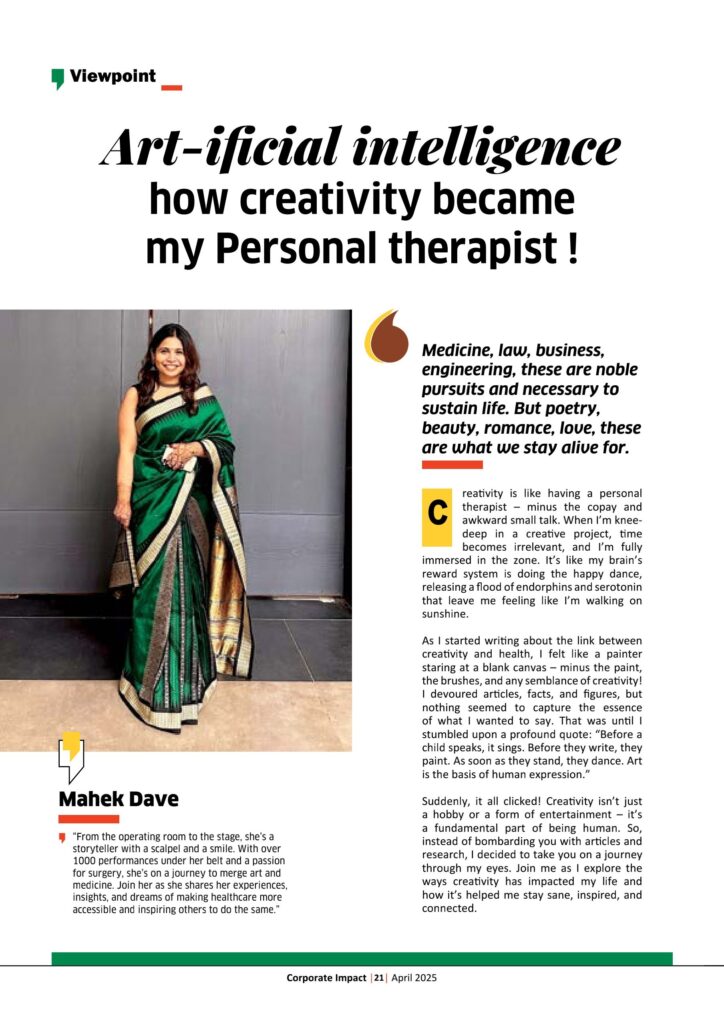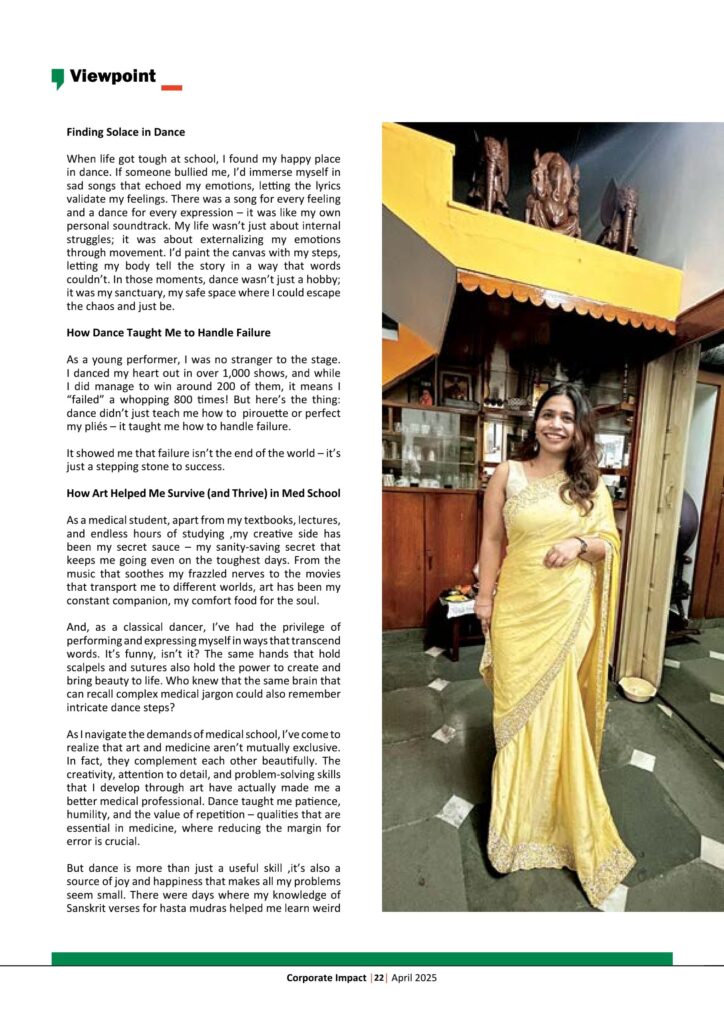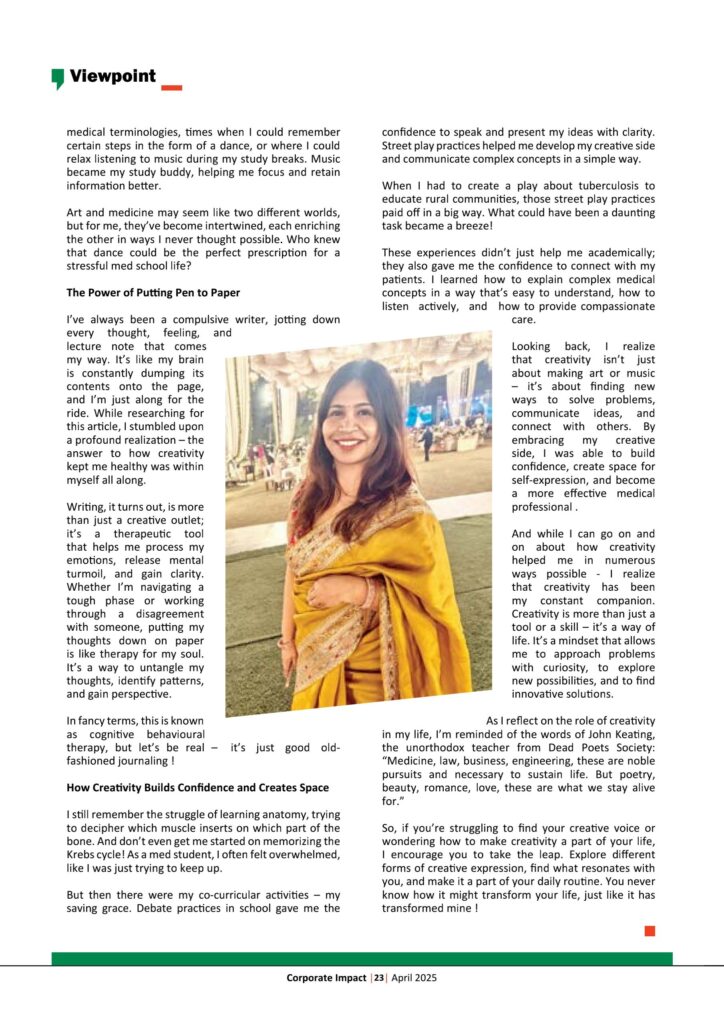Medicine, law, business, engineering, these are noble pursuits and necessary to sustain life. But poetry, beauty, romance, love, these are what we stay alive for.
Mahek Dave
“From the operating room to the stage, she’s a storyteller with a scalpel and a smile. With over 1000 performances under her belt and a passion for surgery, she’s on a journey to merge art and medicine. Join her as she shares her experiences, insights, and dreams of making healthcare more accessible and inspiring others to do the same.”
Creativity is like having a personal therapist – minus the copay and awkward small talk. When I’m knee-deep in a creative project, time becomes irrelevant, and I’m fully immersed in the zone. It’s like my brain’s reward system is doing the happy dance, releasing a flood of endorphins and serotonin that leave me feeling like I’m walking on sunshine.
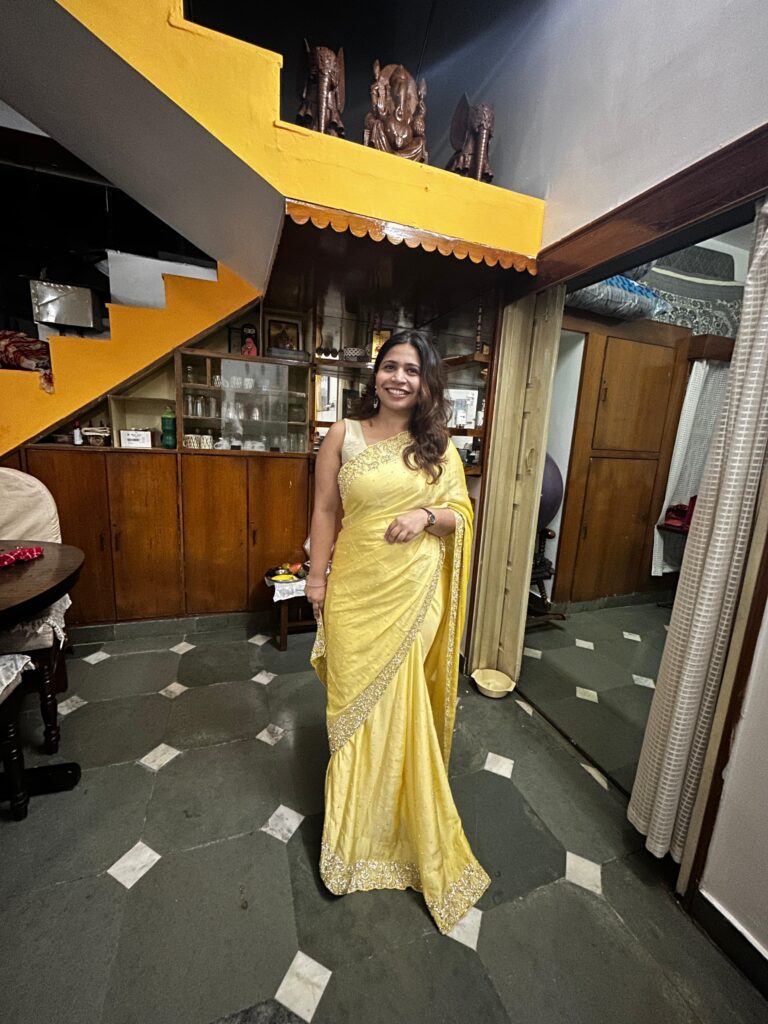
As I started writing about the link between creativity and health, I felt like a painter staring at a blank canvas – minus the paint, the brushes, and any semblance of creativity! I devoured articles, facts, and figures, but nothing seemed to capture the essence of what I wanted to say. That was until I stumbled upon a profound quote: “Before a child speaks, it sings. Before they write, they paint. As soon as they stand, they dance. Art is the basis of human expression.”
Suddenly, it all clicked! Creativity isn’t just a hobby or a form of entertainment – it’s a fundamental part of being human. So, instead of bombarding you with articles and research, I decided to take you on a journey through my eyes. Join me as I explore the ways creativity has impacted my life and how it’s helped me stay sane, inspired, and connected.
Finding Solace in Dance
When life got tough at school, I found my happy place in dance. If someone bullied me, I’d immerse myself in sad songs that echoed my emotions, letting the lyrics validate my feelings. There was a song for every feeling and a dance for every expression – it was like my own personal soundtrack. My life wasn’t just about internal struggles; it was about externalizing my emotions through movement. I’d paint the canvas with my steps, letting my body tell the story in a way that words couldn’t. In those moments, dance wasn’t just a hobby; it was my sanctuary, my safe space where I could escape the chaos and just be.
How Dance Taught Me to Handle Failure
As a young performer, I was no stranger to the stage. I danced my heart out in over 1,000 shows, and while I did manage to win around 200 of them, it means I “failed” a whopping 800 times! But here’s the thing: dance didn’t just teach me how to pirouette or perfect my pliés – it taught me how to handle failure.
It showed me that failure isn’t the end of the world – it’s just a stepping stone to success.
How Art Helped Me Survive (and Thrive) in Med School
As a medical student, apart from my textbooks, lectures, and endless hours of studying ,my creative side has been my secret sauce – my sanity-saving secret that keeps me going even on the toughest days. From the music that soothes my frazzled nerves to the movies that transport me to different worlds, art has been my constant companion, my comfort food for the soul.
And, as a classical dancer, I’ve had the privilege of performing and expressing myself in ways that transcend words. It’s funny, isn’t it? The same hands that hold scalpels and sutures also hold the power to create and bring beauty to life. Who knew that the same brain that can recall complex medical jargon could also remember intricate dance steps?
As I navigate the demands of medical school, I’ve come to realize that art and medicine aren’t mutually exclusive. In fact, they complement each other beautifully. The creativity, attention to detail, and problem-solving skills that I develop through art have actually made me a better medical professional. Dance taught me patience, humility, and the value of repetition – qualities that are essential in medicine, where reducing the margin for error is crucial.
But dance is more than just a useful skill ,it’s also a source of joy and happiness that makes all my problems seem small. There were days where my knowledge of Sanskrit verses for hasta mudras helped me learn weird medical terminologies, times when I could remember certain steps in the form of a dance, or where I could relax listening to music during my study breaks. Music became my study buddy, helping me focus and retain information better.
Art and medicine may seem like two different worlds, but for me, they’ve become intertwined, each enriching the other in ways I never thought possible. Who knew that dance could be the perfect prescription for a stressful med school life?

The Power of Putting Pen to Paper
I’ve always been a compulsive writer, jotting down every thought, feeling, and lecture note that comes my way. It’s like my brain is constantly dumping its contents onto the page, and I’m just along for the ride. While researching for this article, I stumbled upon a profound realization – the answer to how creativity kept me healthy was within myself all along.
Writing, it turns out, is more than just a creative outlet; it’s a therapeutic tool that helps me process my emotions, release mental turmoil, and gain clarity. Whether I’m navigating a tough phase or working through a disagreement with someone, putting my thoughts down on paper is like therapy for my soul. It’s a way to untangle my thoughts, identify patterns, and gain perspective.
In fancy terms, this is known as cognitive behavioural therapy, but let’s be real – it’s just good old-fashioned journaling !
How Creativity Builds Confidence and Creates Space
I still remember the struggle of learning anatomy, trying to decipher which muscle inserts on which part of the bone. And don’t even get me started on memorizing the Krebs cycle! As a med student, I often felt overwhelmed, like I was just trying to keep up.
But then there were my co-curricular activities – my saving grace. Debate practices in school gave me the confidence to speak and present my ideas with clarity. Street play practices helped me develop my creative side and communicate complex concepts in a simple way.
When I had to create a play about tuberculosis to educate rural communities, those street play practices paid off in a big way. What could have been a daunting task became a breeze!
These experiences didn’t just help me academically; they also gave me the confidence to connect with my patients. I learned how to explain complex medical concepts in a way that’s easy to understand, how to listen actively, and how to provide compassionate care.
Looking back, I realize that creativity isn’t just about making art or music – it’s about finding new ways to solve problems, communicate ideas, and connect with others. By embracing my creative side, I was able to build confidence, create space for self-expression, and become a more effective medical professional .
And while I can go on and on about how creativity helped me in numerous ways possible – I realize that creativity has been my constant companion. Creativity is more than just a tool or a skill – it’s a way of life. It’s a mindset that allows me to approach problems with curiosity, to explore new possibilities, and to find innovative solutions.
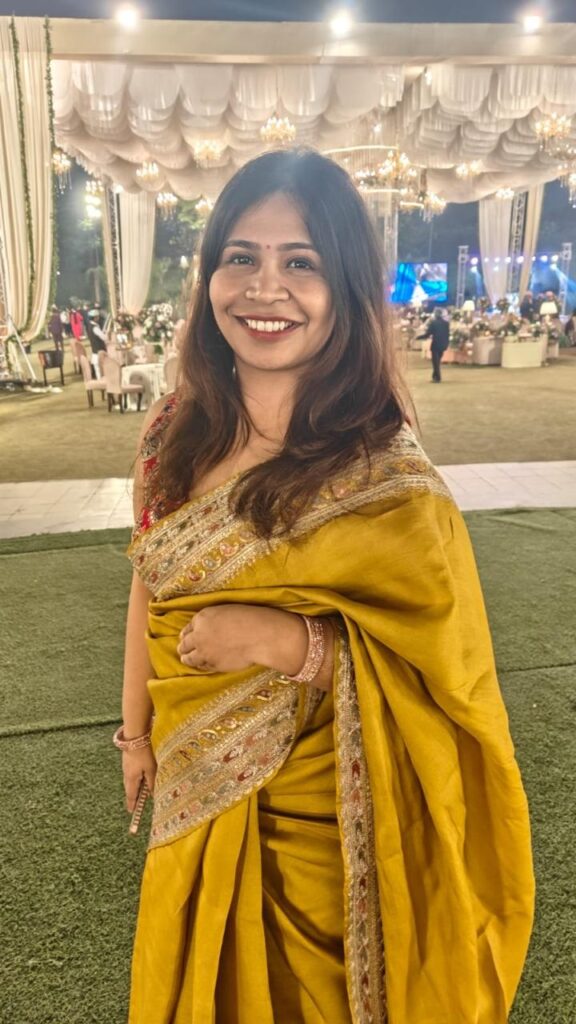
As I reflect on the role of creativity in my life, I’m reminded of the words of John Keating, the unorthodox teacher from Dead Poets Society: “Medicine, law, business, engineering, these are noble pursuits and necessary to sustain life. But poetry, beauty, romance, love, these are what we stay alive for.”
So, if you’re struggling to find your creative voice or wondering how to make creativity a part of your life, I encourage you to take the leap. Explore different forms of creative expression, find what resonates with you, and make it a part of your daily routine. You never know how it might transform your life, just like it has transformed mine !
